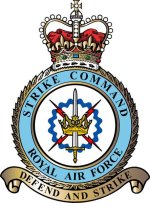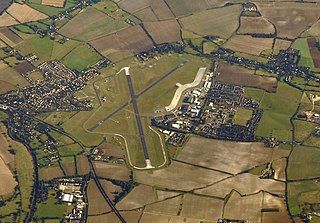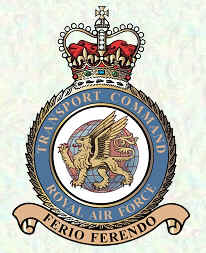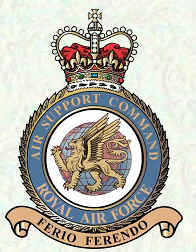
The Royal Air Force's Strike Command was the military formation which controlled the majority of the United Kingdom's bomber and fighter aircraft from 1968 until 2007 when it merged with Personnel and Training Command to form the single Air Command. It latterly consisted of two formations – No. 1 Group RAF and No. 2 Group RAF. The last Commander-in-Chief was Air Chief Marshal Sir Joe French.

The former Royal Air Force Far East Air Force, more simply known as RAF Far East Air Force, was the Command organisation that controlled all Royal Air Force assets in the east of Asia. It was originally formed as Air Command, South East Asia in 1943 during the Second World War. In 1946, this was renamed RAF Air Command Far East, and finally Far East Air Force in June 1949.

Royal Air Force Brize Norton or RAF Brize Norton in Oxfordshire, about 75 mi (121 km) west north-west of London, is the largest station of the Royal Air Force. It is close to the village of Brize Norton, and the towns of Carterton and Witney.

Royal Air Force Benson or RAF Benson is a Royal Air Force (RAF) station located at Benson, near Wallingford, in South Oxfordshire, England. It is a front-line station and home to the RAF's fleet of Westland Puma HC2 support helicopters, used primarily for the transportation of troops & equipment. Flying squadrons comprise No. 33 Squadron flying the Puma, No. 22 Squadron which provides operational evaluation and training for all aircraft in Joint Helicopter Command and No. 28 Squadron, which is the combined Puma and Boeing Chinook HC6A training unit. Other units include the Oxford University Air Squadron and No. 6 Air Experience Flight, both flying the Grob Tutor T1 light training aircraft used for student and cadet flying training. The National Police Air Service and the Thames Valley Air Ambulance are also based at the station, both operating Airbus H135 helicopters.

RAF Transport Command was a Royal Air Force command that controlled all transport aircraft of the RAF. It was established on 25 March 1943 by the renaming of the RAF Ferry Command, and was subsequently renamed RAF Air Support Command in 1967.

Royal Air Force Coningsby or RAF Coningsby, is a Royal Air Force (RAF) station located 13.7 kilometres (8.5 mi) south-west of Horncastle, and 15.8 kilometres (9.8 mi) north-west of Boston, in the East Lindsey district of Lincolnshire, England. It is a Main Operating Base of the RAF and home to three front-line Eurofighter Typhoon FGR4 units, No. 3 Squadron, No. 11 Squadron and No. 12 Squadron. In support of front-line units, No. 29 Squadron is the Typhoon Operational Conversion Unit and No. 41 Squadron is the Typhoon Test and Evaluation Squadron. Coningsby is also the home of the Battle of Britain Memorial Flight (BBMF) which operates a variety of historic RAF aircraft.

Royal Air Force Abingdon or more simply RAF Abingdon is a former Royal Air Force station near Abingdon, Oxfordshire. It is now known as Dalton Barracks and is used by the Royal Logistic Corps.
The RAF Army Co-operation Command was a short-lived command of the Royal Air Force during the Second World War, comprising the army cooperation units of the RAF.

Royal Air Force Finningley or RAF Finningley was a Royal Flying Corps and Royal Air Force station at Finningley, in the Metropolitan Borough of Doncaster, South Yorkshire, England. The station straddled the historic county boundaries of both Nottinghamshire and the West Riding of Yorkshire.

No. 1 Group of the Royal Air Force is one of the two operations groups in RAF Air Command. Today, the group is referred to as the Air Combat Group, as it controls the RAF's combat fast-jet aircraft and has airfields in the UK, as well as RAF Support Unit Goose Bay at CFB Goose Bay in Canada. The group headquarters is located alongside Headquarters Air Command at RAF High Wycombe, Buckinghamshire. The other operational group is No. 2 Group RAF.

No. 3 Group of the Royal Air Force was an RAF group first active in 1918, again in 1923–26, part of RAF Bomber Command from 1936 to 1967, and part of RAF Strike Command from 2000 until it disbanded on 1 April 2006.

RAF Andover is a former Royal Flying Corps and Royal Air Force station in England, 2 miles (3.2 km) west of Andover, Hampshire. As well as RFC and RAF units, units of the Aviation Section, U.S. Signal Corps, Royal Canadian Air Force, United States Army Air Forces, and the Air Transport Auxiliary were also stationed at the airfield.

The Short Belfast is a heavy lift turboprop freighter that was built by British manufacturer Short Brothers at Belfast. Only 10 aircraft were constructed, all of which entered service with the Royal Air Force (RAF), who operated it under the designation Short Belfast C.1.

Air Chief Marshal Sir Harry Broadhurst,, commonly known as Broady, was a senior Royal Air Force commander and flying ace of the Second World War.

Training Command was the Royal Air Force's command responsible for flying and ground training from 1936 to 1940 and again from 1968 to 1977. Training Command was formed from RAF Inland Area on 1 May 1936 and absorbed into RAF Support Command on 13 June 1977. From 27 May 1940 to 1 June 1968, Training Command did not exist as its functions were split into Flying Training Command and Technical Training Command.

No. 18 Group of the Royal Air Force was a group active from 1918 to 1919, and from 1938 to 1996.

No. 38 Group RAF was a group of the Royal Air Force which disbanded on 31 December 2020. It was formed on 6 November 1943 from the former 38 Wing with nine squadrons as part of Transport Command. It was disbanded on 31 January 1951, but re-formed on 1 January 1960, became part of RAF Air Support Command in 1967 and then, in 1972, the air support group within RAF Strike Command. It was temporarily disbanded from 18 Nov 1983 to 31 Oct 1992 and from 1 April 2000 to 1 July 2014. It subsequently became part of RAF Air Command, bringing together the Royal Air Force’s Engineering, Logistics, Communications and Medical Operations units. Air Officer Commanding No. 38 Group was also responsible for UK-based United States Visiting Forces (USVF) units and for RAF personnel attached to other global armed forces.

The former Royal Air Force Near East Air Force, more simply known as RAF Near East Air Force, was the Command organisation that controlled all Royal Air Force (RAF) assets in the Eastern Mediterranean.
No. 224 Group of the Royal Air Force was established during World War II and was operational during the Cold War.
At the end of the Cold War in 1989, the Royal Air Force (RAF) structure was as follows:


















